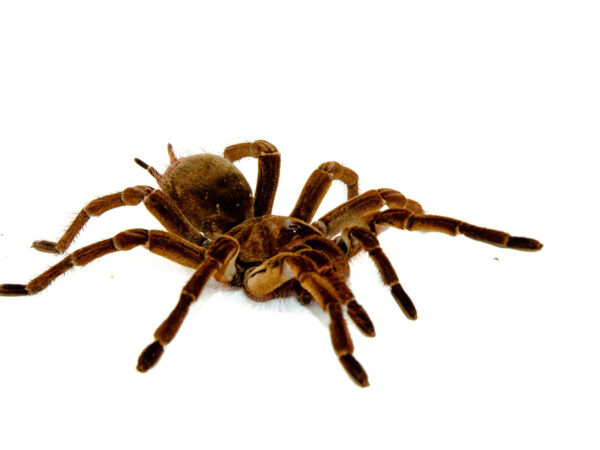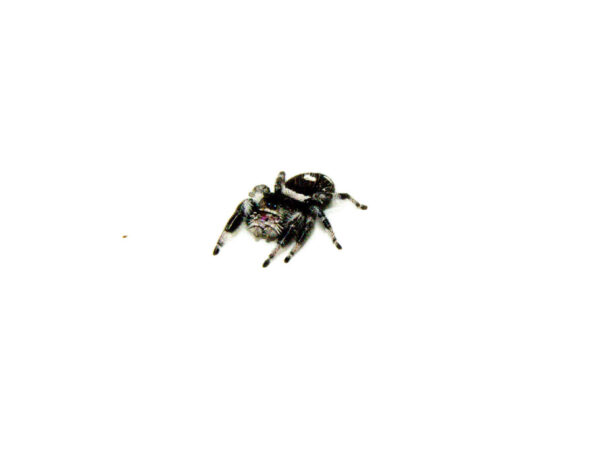The Socotra Island Blue Baboon Tarantula (Monocentropus balfouri) is one of the most uniquely captivating tarantulas in the hobby. Known for its vivid blue legs and cream-colored carapace, it hails from the remote Socotra Island, located off the coast of Yemen in the Arabian Sea. Not only is it admired for its beauty, but it’s also famous for its unusual communal behavior—rare among tarantula species.
If you’re looking to add something exotic, beautiful, and behaviorally intriguing to your collection, the Socotra Island Blue Baboon Tarantula is a top-tier choice.
Appearance and Morphology
What immediately draws attention to the Socotra Island Blue Baboon Tarantula (Monocentropus balfouri) is its striking coloration. The legs are a vibrant metallic blue, contrasting sharply with its creamy, tan upper body and dark chelicerae. This contrast gives it a visually arresting appearance even when viewed from across the room.
Adults typically reach a leg span of 4 to 6 inches. The combination of its size and coloration makes it a prized species for display tanks and advanced collectors.
Behavior and Communal Tendencies
Unlike most tarantulas, Socotra Island Blue Baboon Tarantula can live communally when housed with adequate space and resources. This makes them a favorite among breeders and seasoned hobbyists who enjoy observing social interactions like shared burrows and cooperative feeding.
However, communal setups require close monitoring and planning. Enclosures must be large and filled with multiple hides and plenty of food to prevent cannibalism or territorial aggression.
In terms of temperament, this species is defensive rather than aggressive. They’re fast and may retreat quickly into their burrows when disturbed, rarely resorting to biting unless provoked.
Ideal Habitat Setup
Creating the right environment for Monocentropus balfouri is essential, especially for communal groups.
-
Enclosure Size: 5 to 10 gallons per adult or group setup
-
Substrate: 4–6 inches of dry, loose substrate (coco fiber or topsoil/sand mix)
-
Temperature: 78–82°F
-
Humidity: 60–70% (avoid over-misting; dry conditions with a water dish work best)
-
Hides: Multiple shelters are a must for communal setups
Although this is a desert-dwelling species, a shallow water dish should always be provided. The use of cork bark and stones can help mimic their natural rocky habitat.
Feeding and Growth
This tarantula is a voracious eater, especially in group setups. Feed adults every 7–10 days and juveniles every 4–5 days.
Acceptable food items include:
-
Crickets
-
Dubia roaches
-
Mealworms
-
Small superworms
Growth is relatively fast under the right conditions, and with good husbandry, females can live 12–15 years, while males generally live 3–5 years.
Why Keep a Socotra Island Blue Baboon Tarantula (Monocentropus balfouri) ?
From its brilliant color to its social lifestyle, the Socotra Island Blue Baboon Tarantula (Monocentropus balfouri) offers an experience unlike any other in the hobby. Whether kept alone or in a managed communal setup, this species captivates with both appearance and behavior.
Interested in owning this desert jewel? Browse healthy, captive-bred specimens now at onestopreptileshop.com. Limited availability—these tarantulas sell out quickly due to their rarity and popularity.
Summary
The Socotra Island Blue Baboon Tarantula is not only a breathtaking species with blue highlights and unique markings—it’s also one of the few tarantulas that can live communally in captivity. With proper care and an understanding of their desert-like needs, you can enjoy both the beauty and the social dynamics of this rare arachnid.
Whether you’re an experienced keeper looking to experiment with communal setups or a collector interested in owning one of the hobby’s most visually stunning tarantulas, the Socotra Island Blue Baboon Tarantula (Monocentropus balfouri) won’t disappoint.








Reviews
There are no reviews yet.